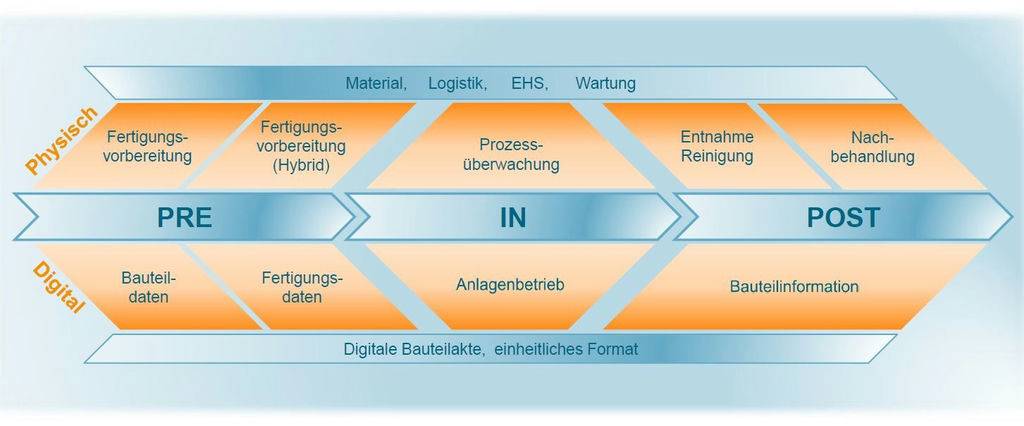Member companies of the VDMA Additive Manufacturing Association have developed detailed roadmaps for additive manufacturing. These will show the industry the way to Smart Factory step by step, and they offer users a comprehensive overview on the state of the art.
Additive manufacturing (AM) creates real added value in an industrial setting. Two-digit growth rates as well as delivery times for AM systems by now taking months both show the young sector’s success. Next to its original applications in prototyping, AM is being used more and more for industrial series production. To this aim, time and cost-efficient interlinked process chains are needed.
Comprehensive know how as a basis for detailed roadmaps
The VDMA Additive Manufacturing Association brings together experts from now roughly 150 member companies and research institutes. They cover all areas of the AM value chain, beginning with software for design, construction, and system control, then building and consumable material, up to AM systems for diverse technologies in the metals and plastics area as well as their multifaceted technological periphery. In addition, suppliers of post-processing and automation solutions as well as specialists for air purification and vacuum conveyor technology are represented. “Hence, our roadmaps are firmly built on the ground of comprehensive industrial experience,” explains Dr. Markus Heering, managing director of the VDMA Additive Manufacturing Association. In the roadmapping process, each discipline represented has shared its perspective on the current state of technology and on future ways for development. On the one hand, potentials and priorities in development became clearer to those technology developers and users that participated. On the other hand, they were able to reach an agreement about standardized terms and interfaces during this process. Heering explains: “Both are important in order to exploit the enormous economic and technological potentials of additive manufacturing.” An agreement about joint goals is a precondition in order to face development in a coordinated manner.
The members of the VDMA Additive Manufacturing Association are convinced of the potentials for series production in additive technologies, and there is much willingness to find agreements for the purpose of fast industrialization. “Against this background, our discussion process has developed a very special dynamic,” reports Rainer Gebhardt, project manager of the VDMA Additive Manufacturing Association. Through their daily practice, member companies are familiar with AM processes and technological approaches. “If you look at it closely, you will find already today hotbeds for comprehensive automation and a consistent in-process quality control. We need to make them available to industrial users as quickly as possible,” he urges. In addition, digital integration with a focus on AM applications in Smart Factory needs to be worked on.
The in-depth work on the roadmap led to a division into plastics and metals processing in powderbed technologies. Here, the working groups have prepared for practical implementation – and they have developed a digital component file for the description of relevant process parameters and component data, so that quality and reproducibility will be guaranteed.
Post-processing is most in need of development
“Only automation of the various work steps will allow for an economical and sustainable production with additive manufacturing technologies. It is here in particular that research and development need to be advanced so as to strengthen the competitive position of additive manufacturing technologies,” urges Christoph Hauck, chairman of the board of the VDMA Additive Manufacturing Association as well as managing director of MBFZ toolcraft GmbH. “The experience gathered as well as integration of traditional manufacturing technologies all offer a large potential for optimization.”
As there are many cross-sectional tasks needing to be solved in the post-processing area, Hauck regards research association projects as the preferred method in this case. “Considering the enormous technological and economical potentials of this technology of the future, it is now all-important to initiate as quickly as possible projects which will be carried out by AM system manufacturers, post-processing and automation specialists, and research institutes together,” he explains. He asserts that government funds would be appropriate due to the technology’s strategic significance for the German industry.
Indeed, the VDMA Additive Manufacturing Association has identified a cross-process need for R&D in their roadmaps. Many tasks in materials logistics, the EHS area, data processing, and process standardization can hardly be tackled by single companies on their own. In order to tackle them nonetheless, everything points to research associations which bring together experience and know how of diverse areas and industries. “We are convinced that our roadmaps provide an accurate summary of the work schedule for the next years,” says Markus Heering, “now, politically responsible persons of vision and innovative fellow campaigners from diverse sectors are needed for us to quickly work through this program.” In the future, AM can and will contribute more to the industrial value chain than can be seen in today’s practice. “We need to watch out so that we will not waste our good starting position and then watch the innovation train leave without us,” he urges.
More than 140 companies and research institutes collaborate under the roof of the VDMA (German Mechanical Engineering Industry Association) in the Additive Manufacturing Association. System manufacturers, suppliers of components and materials, industrial users from the metals and plastics sectors, services providers for software, manufacturing, and finishing as well as researchers all have a common goal: the industrialization of additive manufacturing technologies.


